|
|
Internet-Zeitschrift für Kulturwissenschaften | 17. Nr. |
Februar 2010 |
| Sektion 7.5. | Walls Fallen, Walls Built: Gender and the Issues of Collective Cultural Memory Sektionsleiter | Section Chair: Vorname Name (Ort) |
||
|
|
Internet-Zeitschrift für Kulturwissenschaften | 17. Nr. |
Februar 2010 |
| Sektion 7.5. | Walls Fallen, Walls Built: Gender and the Issues of Collective Cultural Memory Sektionsleiter | Section Chair: Vorname Name (Ort) |
||
Vanishing Cultural Memory in Andreas Gursky´s Photography
Atussa Hatami (Munich / Germany)
e-mail: atussahatami@yahoo.com
Colorful goods in a store, masses of people in a concert, a piece of a grey carpet, shoes lined up in a shoe case, empty hotel interiors, large mountains next to ant-like humans are only a few of the many at first seemingly unrelated topics that Andreas Gursky has photographed over the last fifteen years. But what is it about his images that has made him the most expensive photographer of all times? How do his images, which seem at first very ordinary, capture such a large audience? Is it his choice of the panoramic view combined with the remarkable size of his photographs that hypnotizes the viewer? Or is it perhaps the extreme clarity of the photograph achieved through digital techniques? Could it be that behind his photographs of everyday modern life, there lies another dimension that only comes out upon closer look?
In this paper I will argue that Gursky’s subtle digital manipulation of the images is an inevitable consequence of globalization, that represents the topic of his artwork and enables him to manipulate important topics in the society such as cultural memory and gender.(1) For further analysis, I will use the Lacanian gaze diagram to show how Gursky not only challenges our western normative definition of photography but he rejects western normative perspective by introducing a new way of perception in which the observer loses control and instead floats in the representational space. Gursky´s artwork intimately relates to globalization both with respect of enabling his creative process and defining his image contexts, thereby placing the observer in a floating space. As a result, gender and cultural memory seem to vanish accordingly and are no longer easily locatable.
Dispersal, lack of purpose, silence, indeterminacy, absence, lack of center are only a few of the elements one finds in Andreas Gursky's photographs. Furthermore, his pictures have no distinct frame and do not belong to a specific genre: many resist interpretation. Gursky’s photographs are large scale, up to 10 square meters and colorful, catching the attention of the observer immediately and drawing us into the scene. Our modern life at the turn of the century is the main topic of his photographs. Though his work is global in nature, it is interesting to see that most of Gursky’s photographs that indicate any location do so in the title only, e.g. Genoa, Paris Montparnasse, Shanghai (fig. 1)(2). Yet, they do not represent the uniqueness of a place, but give us a sense of absence of specificity of any place. "Gursky observes contemporary life, but from a distance: it is recorded, captured, elevated"(3). His panoramic photographs are distanced in a way that human beings become ant-like creatures and cars may look like toys (fig. 2)(4). There is incredible amount of detail, clarity and repetition of objects portrayed. Large format cameras and print sizes enable the reproduction of objects with superior sharpness, resolution, and color representation, allowing their perception on two levels: a macroscopic viewpoint, in which the viewer observes the image from a distance, similar to the view of the photographer, and a microscopic level, in which the viewer can immerse himself in the very details.(5)
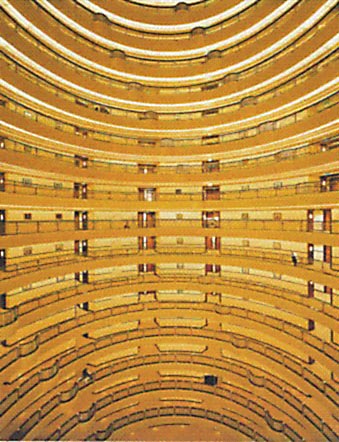 |
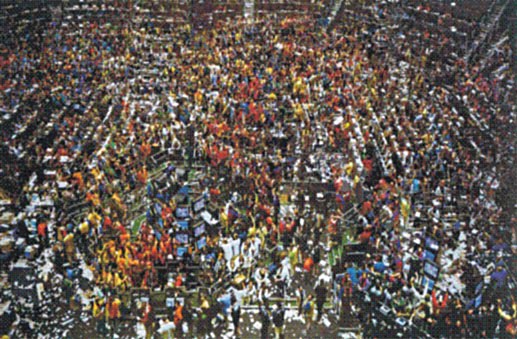
Oben: Fig. 2:Gursky: Chicago Board of Trade II (1999) |
Since 1992 Gursky has started to digitally manipulate his images. The reason behind this intentional manipulation is the inadequacy of the photographic medium to sufficiently reproduce his artistic concepts. The digital revisions are exclusively used to enhance the formal elements of the picture concept that could otherwise not be realized within the frame of an original photograph. However, it is crucial for Gursky's images to have a direct connection to the perceptive reality unlike other artists' work such as Jeff Wall's who uses digital processing to invent pictures. One essential aspect of Gursky's artistic concept is that his images are being antipodes of snapshots lacking momentarity and unnecessary details; instead they become timeless representations of the topics. These constructed but original images share real and artificial components placing them in between photography and painting, which both illustrate and interpret reality.
Since Gursky’s images lay the foundation of a new art, one of the ways in which he is addressing the Western Capitalist society is through a direct dialogue with painting. One of the main characteristics of Gursky's photographs is that they possess a certain painterly quality in their formal appearance, in addition to an intertextual dialogue with former or current painters such as Jackson Pollock or Gerhard Richter in the content of the photographs.
Gursky's constructed representation of photographic images could be equated with Richter's copying of photographs in his paintings. Each one of these artists has to mimic the other medium in order to achieve something elevated in their own medium, something that cannot be captured without the fusion of photography and painting. In Gursky’s own words: "I deliberately use controversial arguments to show that there are countless ways of taking photographs nowadays, and that since the photographic medium has been digitized, a fixed definition of the term 'photography' has become impossible."(6) However, this is not Gursky's point at last. This only becomes his means to other ends. The following discussion will reveal the true reason for Gursky's manipulation in photography.
Untitled VI demonstrates the existing fluidity between the two entities, since Gursky not only applies his painterly knowledge to the surface of the image, but the content of the image itself refers to painting (fig. 3)(7). Untitled VI is a photograph of Jackson Pollock's painting One: Number 31 (1950) in a museum setting, possibly in the Modern Museum of Art, where this piece is permanently on display. At first, the photograph seems to capture reality untouched. However, upon closer look we will see a different reality, a reality constructed by the artist: Gursky has manipulated the painting itself. The original action painting of Jackson Pollock (fig. 4)(8) consists of a creamy background with a very dense surface of drip painting, containing different colors, such as grey, orange, white and black. In the original painting the black color is the most dominant color. It appears on the upper surface of the layering, covering most of the lower levels of color. Owing to the repeated application of paint, the image seems very busy and dark. Each action of the dripping is distinct and separated from the rest of the colors and layers.
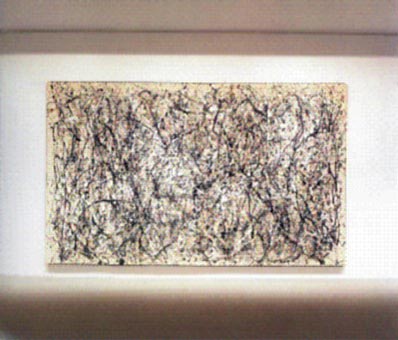 |
Fig. 3 (links): Gursky: Untitled VI (1997)
Fig. 4 (oben): Jackson Pollock: One: Number 31 (1950) |
Now let us compare this original painting with Gursky's reproduction. At first, the reproduction reminds us of a painting of Jackson Pollock without any specific hints regarding its classification and origin. The title of the photograph, Unititled VI does not indicate this either. The lack of title is another level of abstraction that Gursky causes in his photograph of Jackson Pollock's painting. Since most of Pollock's action paintings have similar patterns and are abstract in nature, only a trained eye can recognize the painting in the photograph as Pollock's One: Number 31. Once the identity of the painting has been revealed, a direct and precise comparison can take place when we put the original painting alongside to its photographic reproduction. Only at this point does the observer realize that Gursky has altered the painting dramatically. Whereas the background, the margins, the distinct color drips on the margins, and the reappearance of the most distinct black drips on the uppermost surface are all the same as the original piece, he has clearly changed the bottom layers of paint. The painting seems much lighter than Jackson Pollock's. The dominant overall color is no longer black but white. The color white is spread irregularly on the canvas, but it is hidden underneath the uppermost level of paint which is black. That's why the painting still seems as if it is the original. What identifies the original painting are mostly the final black drips on the surface of the canvas. Gursky has not altered those lines, but changed the subtle color layers underneath.
The question at this point remains: What is the purpose of Gursky altering even an original painting of Jackson Pollock? The fact that Gursky gives the painting a museum setting, makes the observer skip the question about the authenticity of the painting itself: If the photograph was taken in the museum from the painting on the wall, then Gursky's aim is to capture Jackson Pollock's One: Number 31 in its natural environment. However, at the very moment when we believe in an authentic photographic reproduction of the original painting, we already have made a mistake. Gursky's image becomes shocking only in a masked way. After having accepted the photograph as a pure reproduction of Jackson Pollock's painting in a museum setting, Gursky slowly reveals the artificial nature of the image. Through the use of digital technology, he not only comments on the loss of authenticity of the photographic medium through the technological advanced method, but he is able to present the society of the simulacra. The disappearance of the original is not only a phenomenon in photography, but also in our society, where the surface is all we can perceive and comprehend. This is what Baudrillard calls "the triumph of surface"(9) and Debord "the society of spectacle"(10). Only through unmasking of the artificial nature of Gursky's images are we able to understand the society that he is commenting on. According to Gursky: "At the end, the important thing for me is the processing of reality and not realities that have nothing to do with what we experience daily in the world"(11). That is why he does not call the loss of authenticity in photography the "death of the medium" but a "revival" of it.(12)
Gursky's images not only bring a novelty into the realm of Western photography, but they also challenge the Western way of seeing and perception. These images force us into a displaced space in which we are able to see differently. In order to demonstrate this, I will apply psychoanalytical theory to one of Gursky's images. Specifically, I will be using Lacan's gaze theory from a Žižekian angle(13). Žižek defines the gaze as a stain that arises from the picture (fig. 5)(14). While the observer feels to be in charge of the situation as the subject viewing an object at first, Lacan's scopic field demonstrates that the existence of the gaze prevents the observer from staying in control. The function of the gaze is to de-frame and de-center the observer, transforming him/her from the illusory position of being a subject in control to becoming the subject of representation and being out of control. Applying this theory to Gursky's homogeneous images, one notices that they lack a singular particular vanishing point. Instead, Gursky introduces a number of vanishing points arising simultaneously from the picture not only de-framing and de-centering the observer, but also bringing him/her into a space in which the observer will float and no longer have stable ground. The great regularity within the images and the shift between the two- and three-dimensional space causes the lack of a linear perspective. Gursky's images, therefore, undermine on the surface the normative Western linear perspective.
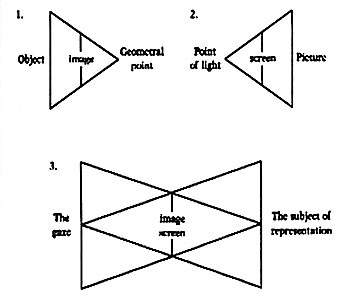 |
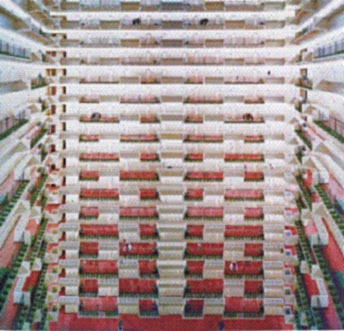 |
Fig. 5 (ganz oben):Lacan: The Scopic Field |
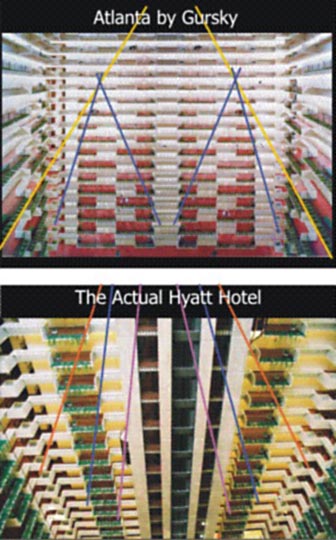 |
Atlanta is the representation of an inner space, in this case, of a hotel in Atlanta (fig. 6)(15). The original size of the photograph (6ft. 1 ¼ in. x 8ft. 4 13/16 in. / 186 x 256cm)(16) makes the observer feel surrounded by the space as if she is occupying the interior.
A comparison of Gursky's photograph with the actual space (fig. 7)(17) shows however, that Gursky could neither have been positioned in the middle of the photograph nor in any one spot in the space that he has represented. Diagrams of the vanishing points in a photo of the actual hotel and Gursky's photograph proof this point (fig. 8)(18). Not only do the vanishing points from either side of the duplicated front wall not match up. But also the two vanishing points do not match with the vanishing point drawn from the side walls. This means that the photograph Atlantais a collage of multiple photographs taken from different angles within the hotel. Although these contradictory details are hidden at the outset, they nonetheless convey an abstract impression to the casual observer. Gursky creates an ambiguous atmosphere where the eyes of the observer constantly switch back and forth between a real structure and a manipulated spectacle.
Overall, as an observant viewer, one moves from being the "subject," observing the scene from the same position as the photographer with total control, to becoming the "subject of representation," aware of the existence of the photographer.
Even though Gursky creates a sense of two-dimensionality and flatness through homogenous colors and the lack of center, the observer initially feels as if she is located within the space represented. The resulting three-dimensional impression gives the observer a sense of control over the scene, even as the flatness and multiple vanishing points take away that sense of true control, and make the observer aware of the photographer's manipulation. The subject consequently loses her singular position of authority and is thus deframed and decentered(19). As we observe, we become aware of the existence of the photographer and therefore, aware of what Lacan describes as the gaze. Lacan's third diagram of the field of vision illustrates the duality we see in Gursky's photographs where the subject is simultaneously the spectator and the spectacle. However, unlike the Lacanian single gaze, the gaze present in Gursky’s photo is a combination of multiple and boundless gazes that arise from the photograph simultaneously. As a result of this phenomenon the subject is deframed and unsettled, floating in the illusionary space.
One of the most influential powers that has enabled the transformation of our society into a society of the spectacle is the mass media. Through the influence of media via advertising, newspaper and TV, our reality has been transformed into an accumulation of countless images, thereby changing our definition of reality and our sense of perception. According to Jameson, we are at a point where "the contents of the media itself have become commodities"(20). He talks about a reversal of a process in which "it is not the commercial products of the market which in advertising become images but rather the very entertainment and narrative processes of commercial television ... are reified and turned into so many commodities"(21).
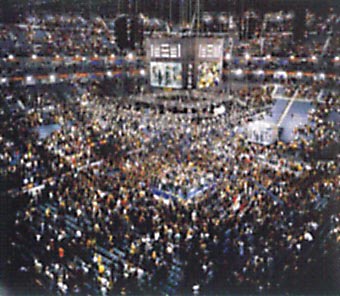
Fig. 9: Gursky: Klitschko (1999) |
The act of medialization becomes very clear in the following example. Klitschko is the representation of a boxing arena (fig. 9)(22). In the center of the picture is a boxing ring filled with people inside. Gursky himself mentions his intentional use of masses of people who are neither old, nor young, nor ugly, nor beautiful in order for the mass to appear homogenous as a whole. Gender becomes subordinate when using the mass as an entity in which the individuals become ant-like and serve the only purpose to represent the mass. The boxing arena is also surrounded by several thousand individuals who have to stand up in order to see. Above the ring there are huge TV screens that could show the crowd what is happening in the ring with accuracy. However, instead of showing the action in the ring, the screens show the booth of the TV reporters who are watching the same action on their own monitors. So we are watching the crowd, some of whom are watching the big screens, and on the screens we are watching the reporters watching what is happening in the ring (and presumably watching us watching them through the mediated screen). This endless self-referentiality, the picture within the picture of a picture watching itself, shows that we no longer observe reality in general as it is, but only through endless mediation as hyper-reality. In this loop of reference, the subject is cast adrift to construct meaning, with no fixed points of reference or truth.
Through skillful mastery of computers, Gursky enabled himself to transfigure his own original imagery into an entirely new dimension. With opulent choice and full control at any stage of the creative production, limitations imposed by technology gradually vanished, thereby unleashing the full verve of his inventive spirit. In fact, Gursky frequently has worked close to the limits defined by current technology which clearly seems constrained only by current boundaries of print technology. All these incremental developments eventually have transformed Gursky´s photography into an internationally recognized art of considerable uniqueness and recognition value.
Interestingly, digital technology also embodies, perhaps, the key aspect of globalization. Globalization at first implies international communication and interactions in the fields of culture, economies, environment, politics, science and religion, thereby affecting the life and the cultural memory of individuals, communities, institutions and societies. “The flattening of the world” as Friedmann calls it(23), at the dawn of the twenty-first century provides opportunities and strain to be felt by any individual person with exceptional immediacy and straightforwardness. The non-abating exposure to data, images, concepts, opinions and ideologies imperceptibly, however constantly reshapes and redefines the cultural memory of our current world at all hierarchical levels of organization.
Fig. 10: Gursky: Madonna I (2002) |
These intimate relationships among digital technology and globalization inevitably and notably affect Gursky´s art. Most of his artwork refers to or is interpreted to refer to one or several contemporary or underlying aspects of globalization. The representation of man as man-kind seemingly contradicts a real expansion of individual opportunities in the age of world-wide internet, however conforms to the uniformity imposed upon many by large-scale prescription of life conditions by economic processes which often are optimized for financial gains for a powerful few. Furthermore, empowerment of the individual in Western societies implies loss of common cultural memory. Many examples for this ambiguity exist in current society and naturally have found their way into Gurskys iconography. The exposure to novel and alien cultural concepts opens the horizon of receptive individuals but leads to questioning of established and comforting ways of thinking, often associated with psychological imbalance and uncertainty. The perception of hu-man in the form of masses implies a subordinate role of gender issues in Gursky´s art. In the few cases, in which individuals are recognizable it is only through the title of the photograph, like Tote Hosen, Formula One teams, and even Madonna (fig. 10)(24) – an otherwise figure of exceptional recognition value and controversy – seems to merely act as integral supplier to the stage of contemporary mankind.
The absence of a single, unique and truthful reference in our cultural memory is reflected by the assembly and organization of Gursky´s images, which not uniformly rely upon established (Western) concepts of vision. The co-existence of several simultaneous and non-hierarchical perspectives places the viewer out of control and causes him/her to float in the represented space. The viewer has to arrange with the composed illusion as a form of reality. This perception and that of the society as a whole with its competing and changing paradigms and values intimately corresponds to a transposed form of gaze. In such a global society terms such as cultural memory and gender are no longer easily locatable. Instead, they float as well in the global space, refusing a final definition.
Anmerkungen:
7.5. Walls Fallen, Walls Built: Gender and the Issues of Collective Cultural Memory
Sektionsgruppen | Section Groups | Groupes de sections